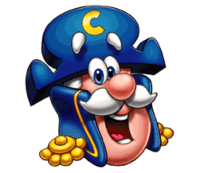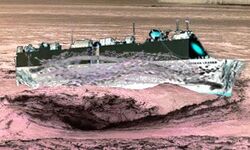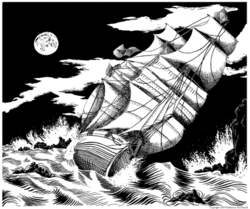Cap'n Crunch
Cap'n Horatio Magellan Crunch was a Cap'n notorious for poor navigation skills that made seven ships of Her Majesty's Fleet go crunch on various rocky shoals. The son of a doctor, he would go on to earn renown for saving his men's lives countless times from being battered to pieces on the rocks next to his latest shipwreck.
Biography
Crunch was pressed into service at the age of five, as was traditional at the time, to officer status as a midshipman. He sought to induce the Admiralty to give him a desk job, perhaps countersigning requisitions, to avoid any real action. Unfortunately, there would be a "shipload" of real action between here and there.
Expedition to the Arctic
Crunch therefore laid in on a Royal Navy exploration vessel travelling to the Arctic with the purpose of killing a grizzly bear. Upon arriving, however, the Arctic turned out not to be all Ocean, as the map claimed; it was in fact a sheet of ice floating on the water. Undeterred, he steered the ship into the ice and caused his first shipwreck, one he would later call "sheer bravery," though all that was sheared was the bow (from the stern). Heroically, Crunch jumped off the ship and landed on the cold ice below with only a rifle and one bullet. According to his memoirs, he then walked across the polar ice sheet to Norway, shooting and killing five "grizzlies" along the way for food.
On reaching Norway, he booked passage on a schooner from Oslo back to Portsmouth. However, he employed the wrong side of the busy shipping lines of the English Channel. "Driving on the left" would go on to become a proud Commonwealth tradition, whilst events compelled him to assume his next command: the ship's only lifeboat, which he used to save his own life as well as those of two seamen who proved as well-suited to the task of rowing back to Hampshire as Crunch was for his destiny of Command.
Pirates of the Caribbean
The Royal Navy, after hearing of these gallant exploits, promoted him immediatly to the rank of Captain and put him in charge of HMS Besington, a frigate en route to Jamaica. Upon reaching the Caribbean Sea, he spotted a pirate ship and attempted to engage it in combat. Unfortunately, his gun crews had insufficient warning to fire. After slipping past the pirates, Crunch turned the Besington at a right angle so that it cut across the path of the pirate ship. This resulted in an immediate collision and yet another shipwreck.
He swam ashore, but the island turned out to be a French colony. He immediately charged into the garrison defending the fort and lost an arm to a whisk expertly wielded by a French chef. Outnumbered and now out-armed, he fled for the nearest ship; to-wit, the SS Jacquois, a four-foot rubber dinghy. He proudly sailed out of the French harbour, flying the White Ensign, minus the Union Jack, as he couldn't find a British flag at the time but he did have one pair of clean underpants. On approaching the coral reef just outside the harbour wall, he ran aground on a sea anemone: his fourth shipwreck.
East Anglia
Denmark, in loose alliance with Russia, was raiding East Anglia with long boats and killing monks. As this was a threat to tourism in the region, Crunch was sent with the Fleet Admiral to attack the main Danish naval base at Copenhagen.
The British fleet moored outside the harbour but the Admiral did not signal the attack. Crunch took personal control and entered Copenhagen harbour, in the HMS Agamemnon, around the vicinity of the porn shops. The Agamemnon, unfortunately, succumbed to anti-ship defenses that the Danes had constructed out of reinforced Lego blocks, a munition that still constitutes most of Denmark's national defense to this day. Helpless, the ship stood upright in the shallow waters. Crunch jumped into the water and swam for the nearest British ship, "leading from behind," to quote an Obama aide from a very different era, and surely communicating the strategic intelligence that secured the British victory.
Valiant defeat of the French
His actions were deemed so crucial in turning the tide of the ongoing war, and he had made so many purchases in the porn district, that Crunch was made Vice Admiral and sent after the main French navy and Napoleon himself. Napoleon's navy was lined up in a row at Alexandria. Crunch engaged the French fleet in what would be known as the Battle of the Nile. Unfortunately, he sailed the HMS Culloden right past the French and into a sand bar.
Seeking an escape route, Crunch commandeered the HMS Victory and sank three ships to win the battle before it too ran aground. He presciently promoted his first Lieutenant to Captain a few seconds before this latest crunch, pursuing the fine naval tradition of scapegoating. Crunch himself was credited for Britain's greatest naval battle to date and became Admiral of the Mediterranean fleet.
The corpse of a hero
Later that year, a Spanish and French fleet approached Cape Trafalgar. Crunch ordered his own fleet given the now-famous call, "England expects every man to shake your booty," though his baffled signaler advised a slight rewording.
Crunch's men boarded the French ship La Marseille and fought hand-to-hand, while Crunch himself strove against the wheel. But a French sniper, realising that Crunch was no mere taxi driver but the Admiral himself, did what snipers everywhere do best. Crunch was mortally wounded and his men found him slumped against the deck, yet with one hand still on the wheel, a posture they interpreted as an intention to remain in command. Unfortunately, under this arrangement, HMS Victory sailed straight into HMS Ajax and sank like a rock, with Crunch still holding the wheel, appropriately going down with the ship.
In 2005, 200 years after the famous Battle of Trafalgar, Crunch's body was ceremoniously dredged from the bottom of the seabed and placed in a gold coffin aboard a schooner to be returned to Britain. However, the coffin slipped out of its rack and made a hole in the side of the ship. The ship sank and the coffin was never recovered. Technically, this is not regarded as an eighth Crunch shipwreck.
Other Cap'n Crunches
Horatio Crunch IV
Crunch's great-grandson also served in the Fleet. During World War II, the Admiralty decided that by far the safest place for Crunch was on loan to the U.S. Navy for service in the Pacific campaign, commanding the USS Caine. Crunch's surname served perfectly for a nation that speaks while chewing. Unfortunately, Crunch's signature circular course, now studied at the Naval Academy as the "Froot Loop," became problematic — as orbiting would not come into vogue as a tactical maneuver until the dawning of the Space Age two decades later — and a notorious episode involving missing strawberries dominated his missions. He was dropped into the shark-filled waters of maritime law. It was a relief when he was finally recalled to Britain and given the rank of Commodore for his bravery, continuing his family line's work of proving itself ideal for desk jobs.
Breakfast cereal
Astonishingly, there is a Quaker Oats breakfast cereal by the same name. It was developed based on fond memories of breakfast in Derry, New Hampshire. (Derry is reached via the Alan Shepard Expressway, and signs at the edge of town proclaim Derry "The Birthplace of Cap'n Crunch," though it is obviously the birthplace of useless commemorations.) PepsiCo nutritionist Pamela Low described the cereal as having a flavor she called "want-more-ishness." Executives at the company had been toying with an identical idea and were enthused that Low had achieved it without use of either caffeine or heroin, the two options the company had been studying. The corporate plan consumed the new-product idea in a single gulp, with no crunches.
The cereal has been available in 18 varieties, all tediously listed on Wikipedia for readers who care about stuff like that.
Controversy
Quaker's plan to make the breakfast cereal physically addictive evolved into a plan to encourage repeat purchase by sticking loot in the cereal box. One such trinket was a Cap'n Crunch Bos'n's Whistle. In 1971, Air Force technician John Draper discovered that these whistles emitted a tone at exactly 2600 Hz. There was no other way to hit this note in the United States at the time, though pioneers such as Louis Armstrong had tried. Blowing the Bos'n's Whistle into a telephone would not only annoy the person called but would open the entire United States infrastructure to hacking and enable the blower to operate the nuclear arsenal. Draper was sentenced to five years in prison for toll fraud, after he fatefully turned his attention from taking over the U.S. military to breezing through toll booths. He was easily apprehended because his fake EZPass transponder sent signals to a system that was not yet in use on the toll road.
In 2009, plaintiff Janine Sugawara sued PepsiCo, saying that for four years, she had faithfully eaten Cap'n Crunch (and occasionally sucked off Tony the Tiger) believing that the "crunchberries" in the cereal were actual fruit. (Shockingly, they are actually just more candy.) Judge Morrison England, Jr. threw her case out of court, saying it offended common sense and that she should not return until she had committed a crime worthy of the name. Once again, however, there was a free prize in the box: As a consolation, Judge England declared Sugawara Permanently Unable to Work on the grounds of being an abject moron. He also qualified her for a parking placard because, due to her faithful use of the product, she now tips the scales at 400 lbs.
See also
| Featured version: 23 July 2013 | |
| This article has been featured on the main page. — You can vote for or nominate your favourite articles at Uncyclopedia:VFH. | |
| |||||||||||||||||||||





